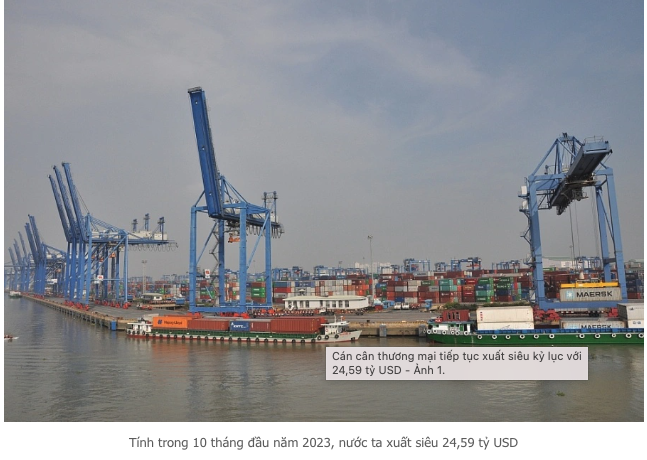Aquatic product exports are crucial to Vietnam’s economy. The aquatic product industry is one of the important contributors to the gross domestic product (GDP), providing employment opportunities for millions of people. As an important industry in the country, aquatic products offer great potential for Vietnam’s economy and global logistics services. Despite still facing challenges, the aquatic product industry still plays an important role in the international market and has achieved great international success for Vietnam.
The importance of aquatic product exports is as follows:
Source of export income: The export of aquatic products has brought a large amount of foreign exchange income to the country by selling products to the international market. Attracting these capital inflows will help boost total exports and foreign exchange reserves, enhancing Vietnam’s economic strength in the international market.
Creation of employment opportunities: The fishery industry provides a large number of employment opportunities for the people, especially in coastal and rural areas. Job creation can help reduce unemployment and reduce urbanization pressures.
Promoting local economic development: Aquaculture exports contribute to economic development in coastal and rural areas where natural resources and aquaculture potential are abundant. This helps to narrow the development gap between regions within the country.
Promoting the export of agriculture, forestry and aquaculture: The export of aquatic products will help increase the total export value of Vietnam’s agriculture, forestry and aquaculture. It also means promoting economic diversification and reducing the impact of changes in international markets on some key economic sectors.
Contributing to agricultural development: Aquaculture is an important component of agriculture and contributes to balancing and enhancing domestic agricultural production. This will help increase export opportunities for Vietnamese agricultural products and ensure food supply in the domestic market.
In conclusion, aquatic product exports play an important role in Vietnam’s economy, from providing important export income and job creation, to promoting the development of local economy and agriculture. There is a need to intensify the development and enhancement of this area to continue to make a positive contribution to the sustainable development of the country.
Vietnam’s aquatic product export market status
According to statistics from the Vietnam Association of Aquatic Products Processing and Export (VASEP) in 2019, the growth rate of the output value of aquatic products reached 6.25%, compared with the whole year of 2018. The total production in 2019 was about 8.15 million tons, an increase of 4.9%, including harvesting production of 3.77 million tons, an increase of 4.5%; breeding production reached 4.38 million tons, an increase of 5.2%. Overall, aquatic product exports totaled approximately US$8.6 billion in 2019.
Among the main product groups, only tuna maintained a growth rate of nearly 12%, while other commodities showed a downward trend. Notably, shrimp products fell by almost 5 percent; fish by 12 percent; and squid and octopus by 13 percent. Meanwhile, relative growth in exports of other fish species reached 15 percent, helping to limit the decline in overall export value
Through the development of global logistics services, Vietnamese aquatic products have been exported to all over the world. my country’s largest import markets are the United States, Japan and China. However, the export of aquatic products in early 2020 suffered a significant decline in the first few months due to the impact of the Covid-19 epidemic. It can be seen that the important reason is that export prices are affected, as countries implement measures to restrict movement, which negatively affects the connectivity of global logistics services
Opportunities and challenges of Vietnamese aquatic products
Opportunity
Vietnam has abundant natural resources, such as long coastline, diverse river and lake systems, which are conducive to the cultivation of various aquatic products. In addition, there are many kinds of warm currents and cold currents with different temperatures in the sea area of Vietnam, which provide abundant fish and seafood for the fishing industry. Vietnamese fishermen have a long tradition of sea fishing and have established distant sea fishing villages. Therefore, Viet Nam can provide a large amount of safe and stable aquatic products both domestically and internationally through sufficient supply and potential from 28 coastal provinces, as well as a developed processing industry with more than 600 export enterprises.
The Vietnamese government has paid more and more attention to the development of the aquatic product industry, formulated large-scale development goals and plans, and established a strategic and systematic production and management system. In addition, the aquatic product industry and aquatic product companies are paying more and more attention to food safety and environmental social responsibility. Many breeding areas and processing plants have implemented HACCP, and many breeding areas and processing plants have also obtained certifications such as ASC, GLOBAL GAP, MSC and VietGAP. Continuous certification. Therefore, Vietnamese aquatic products have established a reliable food brand, loved by domestic and international consumers.
The developed processing technology can produce diversified and high value-added products. Highly skilled labor force, stable supply chain and closed-loop, cooperative chain mode implemented in various industries can meet the needs of customers in various countries.
Many Free Trade Agreements (FTAs) have been signed with various countries and regions, bringing advantages in export and import taxation, as well as opportunities to improve product quality. So far, Vietnam has signed FTAs with 16 countries, accounting for 73% of Vietnam’s total export value of aquatic products, of which 13 FTAs have been signed, accounting for 71% of Vietnam’s total export value of aquatic products. In addition, the EU-Vietnam Free Trade Agreement (EVFTA) has come into force since August 2020, and the UK-Vietnam Free Trade Agreement (UKVFTA) will boost exports to the European Union and the UK, creating more opportunities for exporting companies.
Especially at the current stage, the global food crisis is happening quietly, and the situation is very tense. Food prices have risen by 30% in the past year due to the Covid-19 outbreak and the conflict in Ukraine, according to the United Nations Food and Agriculture Organization (FAO), and global supply chains have been severely affected. In response to this situation, more and more countries choose to cut exports and strengthen their food and agricultural product reserves. These moves could exacerbate food shortages and keep prices rising. However, this has increased export opportunities for Vietnamese businesses to meet growing global demand.
As a country with many advantages in the agricultural sector, Vietnam is expected to become an important food supplier and contribute to solving the food crisis in Africa. This is seen as a strategic opportunity for Vietnam. When having a rich and stable supply of commodities, Vietnam can easily reach long-term cooperative supply agreements with other countries. This will showcase Vietnam’s vital role and provide “soft power” to domestic production to facilitate reinvestment
Challenge
and climate change. This has serious implications for planning, production structures and people’s farming habits. In particular, the status quo of environmental pollution in rivers, lakes and some sea areas has resulted in the death of a large number of aquatic products, seriously affecting the output and quality of exports.
The “hot” growth in some seafood markets has also created many problems, especially with seasonal supply causing prices to fall. In addition, exchange rate changes and market fluctuations have also had a great impact on enterprises and the entire aquatic product industry.
Obviously, some markets place great emphasis on factors such as food safety, such as “yellow card IUU” and other standards, which Europe is applying to aquatic products from Vietnam. Food quality, inspection and quarantine and food safety standards in various countries are becoming more and more stringent
At present, China is still a market with great potential, but stricter controls have been imposed on the import of frozen food, so Vietnamese seafood enterprises need to continuously improve quality, comply with guidelines, and prevent the Covid-19 epidemic to meet the requirements of importing countries.
For some finicky markets, such as the US, Europe and Japan, there is a high risk of seafood being returned, which will damage the reputation of Vietnam’s seafood industry.
The current Russia-Ukraine conflict and energy crisis are causing great difficulties for business. Crude oil prices are rising and hitting new highs, leading to higher transportation costs, which in turn raise production costs.
Exports of aquatic products will face huge challenges in the future due to the shortage of raw materials to ensure production and export, rising shipping costs and many problems related to the Covid-19 epidemic. Export orders are currently placed in advance, and export prices have not yet fully compensated for rising production costs amid the Covid-19 pandemic. This is a burden for exporting companies, reducing their profits.
Ho Chi Minh City collects port usage fees for import and export goods, implements inspection and quarantine on domestic water and land transport goods, and implements quarantine on frozen aquatic products used as raw materials for export processed food, all of which are difficult issues for aquatic product companies. ”










